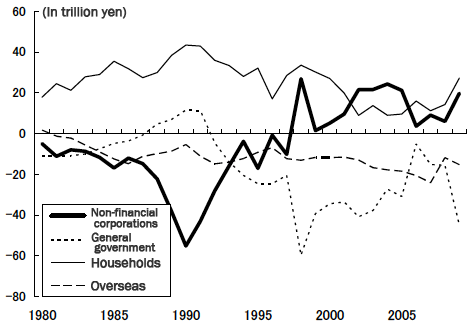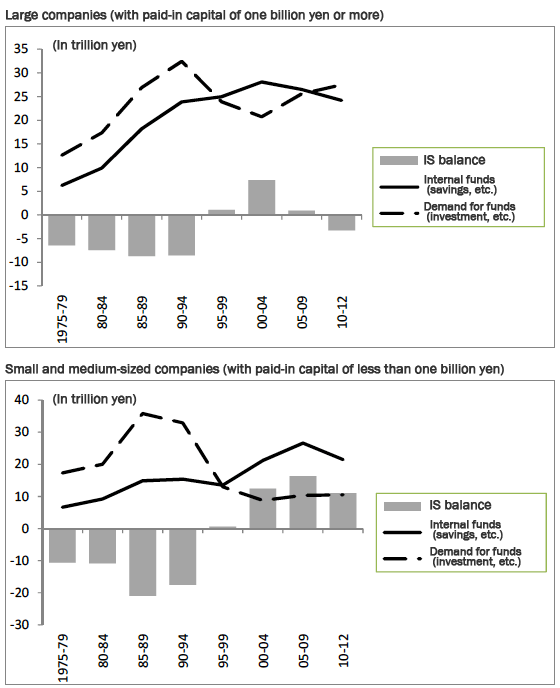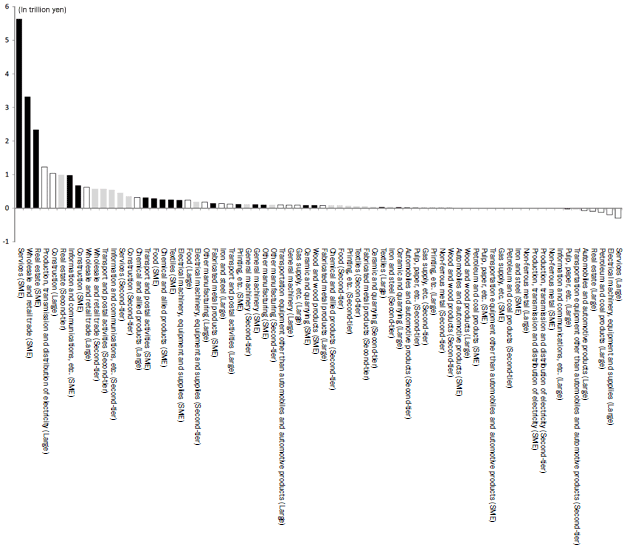Helped by quantitative and qualitative monetary easing introduced in April 2013 combined with fiscal stimulus to the tune of 10 trillion yen, Japan's economy has been on a recovery trail. However, the pace of recovery has slowed noticeably since around mid-2014. An increase in the burden on the general public resulting from the consumption tax rate hike is a direct cause but does not fully explain the downward swing in the nation's economic performance over the past few months. Against this backdrop, the Bank of Japan (BOJ) eased its already loose monetary policy (on October 31, 2014).
Depressed business sentiment
Other factors cited as causing the downward swing include the following: 1) the consumption stimulating effect of higher stock prices has weakened as the effect of monetary easing has run its course, and 2) the yen's depreciation has had a limited export-boosting effect as Japanese manufacturers already had moved significant portions of their manufacturing bases abroad. Undoubtedly, those factors cannot be ignored. However, another major factor is that while a number of Japanese companies have been reporting record earnings, many companies remain cautious about investing in facilities and raising employee salaries.
If personal consumption boosted by higher stock prices is the first engine, the second engine known as business management has not been fully ignited. More simply put, business sentiment remains depressed.
As it is difficult to brighten up business sentiment, corporate managers tend to be cautious in decision making, which in turn prevents the Japanese economy as a whole from gaining momentum. Ending this vicious cycle is not easy because business sentiment deteriorated with reasons. Domestically, the size of the market is unlikely to expand significantly in the future due to an aging of the population and persistently low fertility. Meanwhile, overseas economies?particularly emerging markets?are expected to achieve strong growth in the coming years, prompting the further shifting of production from Japan to overseas. This results in reduced domestic job opportunities and puts additional downward pressure on Japan's economic growth.
Persistent underinvestment in the corporate sector
In this article, I would like to focus on the structural excesses of Japanese companies that were built up during the Japanese bubble years as yet another major factor behind the current cautious business sentiment. As a key concept for that, I consider the investment-saving (IS) balance, a measure to gauge the level of investment activity in the corporate and household sectors. The IS balance is the net difference between the amount saved and the amount invested, which represents the ultimate demand for funds or a critical node linking the financial (money) and real (goods) economies.
Figure 1 shows the changes in Japan's IS balance by sector. The household sector has been maintaining a surplus of saving over investment, but the gap between the two has been shrinking in recent years. The biggest factor behind this is an aging population and low fertility. Meanwhile, the government sector has seen a sharp increase in its saving deficit since the 1990s and onward. In order to prop up the post-bubble Japanese economy, the government injected public funds into banks to stabilize the financial system and financed public investment programs by issuing government bonds. Amid this situation, the corporate sector has been showing a distinctive pattern, making a sudden shift from a persistent deficit through the mid-1990s to a saving surplus thereafter. In terms of the direction of changes, the government and household sectors moved toward decreasing savings whereas the corporate sector alone increased savings.

A shift from a saving deficit to a saving surplus occurs when there is (i) an increase in savings, (ii) a decrease in investment, or if (iii) both of the foregoing events happen. Statistical processing of the data on developments in the corporate sector found that (iii) has been the factor for the shift observed in Japan. In the 1990s and onward, the Japanese corporate sector decreased investment and increased savings simultaneously, both operating to drive a shift toward a saving surplus.
Of these, how the decrease in investment occurred would be easy to understand. In the aftermath of the over-investment during the bubble period, Japanese companies struggled to reduce excess facilities and could not afford to make new investment. On the other hand, the increase in savings is not necessarily intuitively understandable. Why did Japanese companies increase savings? Putting the conclusion first, they needed funds for the payment of their bloated debts. An increase in savings would not change the IS balance if the incremental amount is invested (i.e., if accompanied by an increase in investment by the same amount). In reality, however, Japanese companies used their incremental savings to repay their debts.
After carrying the heavy burden of the so-called capital stock adjustment problem?i.e., excess capacity in facilities and debt overhang?for so long, Japanese companies were not ready to shift to forward-looking business plans in response to subtle improvements in the macroeconomic situation.
Business metabolism and stagnant capital stock adjustments
Now, let's take a closer look at the IS balance of the corporate sector. For this purpose, we used the IS balance by company size and type of industry, calculated based on data from the Ministry of Finance's Financial Statements Statistics of Corporations by Industry. We can see that the reason for the saving surplus after 2000 lies primarily in the small and medium-sized enterprises (SMEs) (Figure 2). While large companies have turned the IS balance into a slight saving surplus or a modest saving deficit since the 2000s and onward, SMEs have been continuing to run a significant saving surplus.


[Click to enlarge]
Even among the top three segments, SMEs in the services industry stand out in the size of saving surplus. It is difficult to readily think of background factors for this situation. However, a closer examination of this particular segment, which involves further breaking it down in terms of both industry type and company size, shows that most of the saving surplus is accounted for by micro enterprises (For further details, see Goto (2014), Macro-performance of Small and Medium Enterprises).
During the bubble period, Japanese companies more or less developed a tendency to borrow, invest, and/or expand excessively regardless of their size and industry. Following the burst of the bubble, large companies managed to complete financial restructuring in a relatively short period of time, mobilizing their internal funds to pay off their debts and write off uncollectible receivables. However, SMEs were slow to make such adjustments, and a series of liquidity support measures implemented by the government served only to help them maintain their excess capacity. An exit from the market is surely an extremely painful ordeal. However, it also means forcible debt restructuring. In a sense, the government's liquidity support to keep otherwise bankrupt SMEs going helped delay the debt restructuring process on the macroeconomic level.
This phenomenon occurred not only among SMEs in the so-called "bubble-related industries" but also across a broad range of mostly unknown SMEs that operate in various parts of the country, such as those classified as "other services," an assortment of miscellaneous types of business. The government's support to SMEs has been applied thinly and broadly. In terms of its aggregate impact on the national economy, it is highly likely that such support for SMEs has had a significant influence on the capital stock adjustments in the corporate sector.
The presence of large excess liquidity in the corporate sector symbolizes a lack of dynamism in the Japanese economy, which is believed to have been providing a critical background for Japanese companies to remain cautious despite bold fiscal and monetary policies by the government and the BOJ. However, things are changing. Large companies have completed capital stock adjustments and SMEs are making progress. There is no escaping the influence of an aging population and low fertility or that of the rapid growth of emerging economies. At the very least, however, now that Japanese companies?including SMEs?are finally ridding themselves of structural excesses, one of the major problems that have long been dampening business sentiment, they will find it easier to make forward-looking business plans.


